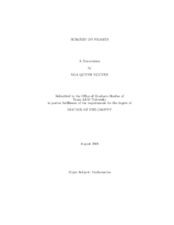| dc.description.abstract | In this dissertation, we investigate methods of modifying a tight frame sequence
on a finite subset of the frame so that the result is a tight frame with better properties.
We call this a surgery on the frame. There are basically three types of surgeries:
transplants, expansions, and contractions. In this dissertation, it will be necessary to
consider surgeries on not-necessarily-tight frames because the subsets of frames that
are excised and replaced are usually not themselves tight frames on their spans, even
if the initial frame and the final frame are tight. This makes the theory necessarily
complicated, and richer than one might expect.
Chapter I is devoted to an introduction to frame theory. In Chapter II, we
investigate conditions under which expansion, contraction, and transplant problems
have a solution. In particular, we consider the equiangular replacement problem.
We show that we can always replace a set of three unit vectors with a set of three
complex unit equiangular vectors which has the same Bessel operator as the Bessel
operator of the original set. We show that this can not always be done if we require
the replacement vectors to be real, even if the original vectors are real. We also prove
that the minimum angle between pairs of vectors in the replacement set becomes
largest when the replacement set is equiangular. Iterating this procedure can yield a
frame with smaller maximal frame correlation than the original. Frames with optimal
maximal frame correlation are called Grassmannian frames and no general method
is known at the present time for constructing them. Addressing this, in Chapter III
we introduce a spreading algorithm for finite unit tight frames by replacing vectors three-at-a-time to produce a unit tight frame with better maximal frame correlation
than the original frame. This algorithm also provides a “good” orientation for the
replacement sets. The orientation part ensures stability in the sense that if a selected
set of three unit vectors happens to already be equiangular, then the algorithm gives
back the same three vectors in the original order. In chapter IV and chapter V, we
investigate two special classes of frames called push-out frames and group frames.
Chapter VI is devoted to some mathematical problems related to the ”cocktail party
problem ”. | en |


